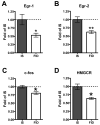Long-term reduction of hippocampal brain-derived neurotrophic factor activity after fetal-neonatal iron deficiency in adult rats
- PMID: 19190544
- PMCID: PMC2715440
- DOI: 10.1203/PDR.0b013e31819d90a1
Long-term reduction of hippocampal brain-derived neurotrophic factor activity after fetal-neonatal iron deficiency in adult rats
Abstract
Fetal-neonatal iron deficiency acutely alters hippocampal biochemistry, neural morphology, and electrophysiology accompanied by a downregulation of brain-derived neurotrophic factor (BDNF). These changes provide a cellular and molecular basis for observed short-term learning and memory impairments. However, the etiology of residual, long-term hippocampal neurotransmission abnormalities and learning impairments after treatment remain unclear. Because BDNF modulates learning and memory, we assessed its expression in 65-d-old formerly iron deficient (FID) male rats that had been iron deficient during the fetal-neonatal period and treated with iron since postnatal day 7. BDNF-III and -IV mRNAs and BDNF protein expression remained down-regulated in FID rats when compared with the always iron-sufficient rats. Expressions of BDNF activity-dependent downstream targets (3-hydroxy-3-methylglutaryl CoA reductase and immediate early genes c-fos, early growth response gene 1 and 2) were reduced in FID rats. In turn, hippocampal expressions of direct targets of early-growth response genes, including hypoxia-inducible factor 1, dual-specificity phosphatase 4, IGF 2, and myelin basic protein were also diminished in FID rats. Collectively, fetal-neonatal iron deficiency lowers hippocampal BDNF expression and function beyond the period of iron deficiency. These findings may underlie the persistence of learning deficits seen after fetal-neonatal iron deficiency.
Figures


References
-
- Georgieff MK, Wewerka SW, Nelson CA, Deregnier RA. Iron status at 9 months of infants with low iron stores at birth. J Pediatr. 2002;141:405–409. - PubMed
-
- Petry CD, Eaton MA, Wobken JD, Mills MM, Johnson DE, Georgieff MK. Iron deficiency of liver, heart, and brain in newborn infants of diabetic mothers. J Pediatr. 1992;121:109–114. - PubMed
-
- Chockalingam UM, Murphy E, Ophoven JC, Weisdorf SA, Georgieff MK. Cord transferrin and ferritin values in newborn infants at risk for prenatal uteroplacental insufficiency and chronic hypoxia. J Pediatr. 1987;111:283–286. - PubMed
Publication types
MeSH terms
Substances
Grants and funding
LinkOut - more resources
Full Text Sources
Miscellaneous

